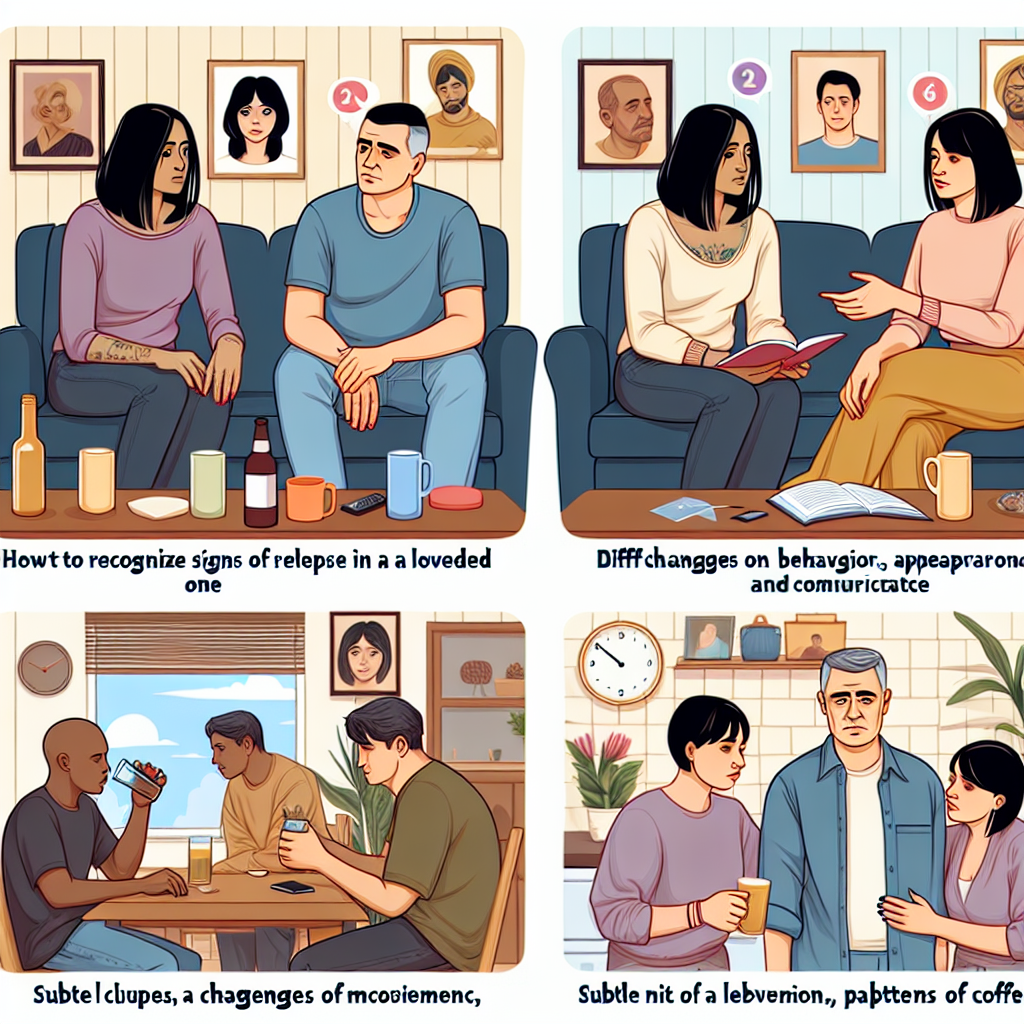-
Table of Contents
“Spot the Signs: Safeguard Your Loved One from Relapse”
Introduction

Recognizing the signs of relapse in a loved one is crucial for providing timely support and intervention. Relapse, a return to substance use after a period of abstinence, can be a challenging and disheartening experience for both the individual and their loved ones. Understanding the warning signs can help in identifying potential issues early and taking appropriate steps to address them. This guide will explore the common indicators of relapse, including behavioral changes, emotional shifts, and physical symptoms, and offer practical advice on how to approach and support a loved one who may be struggling. By being vigilant and informed, you can play a vital role in helping your loved one maintain their recovery journey.
Identifying Behavioral Changes: Key Indicators of Relapse
Recognizing the signs of relapse in a loved one can be a challenging yet crucial task. Behavioral changes often serve as key indicators that someone may be slipping back into old habits. By understanding these signs, you can offer timely support and potentially prevent a full-blown relapse. One of the first things to look for is a shift in their daily routine. If your loved one starts neglecting responsibilities, such as missing work or skipping important appointments, this could be a red flag. These changes often indicate that they are struggling to maintain the structure that once helped them stay sober.
Another significant indicator is a change in social behavior. If your loved one begins to isolate themselves, avoiding friends and family, this could be a sign that they are experiencing internal turmoil. Conversely, they might start hanging out with old acquaintances who were part of their substance-using past. This shift in social circles can be a precursor to relapse, as it often brings them back into environments where they are more likely to use substances again.
Mood swings and emotional instability are also critical signs to watch for. If your loved one becomes unusually irritable, anxious, or depressed, these emotional changes could be indicative of an internal struggle. They might also exhibit signs of overconfidence, believing they can handle “just one drink” or “one hit” without falling back into addiction. This overconfidence can be particularly dangerous, as it often leads to a slippery slope of repeated use.
Physical changes can also serve as warning signs. Noticeable weight loss or gain, changes in sleep patterns, and a general decline in personal hygiene are all potential indicators that something is amiss. These physical symptoms often accompany the emotional and behavioral changes, creating a more comprehensive picture of the relapse risk.
Financial issues can also be a telltale sign. If your loved one starts borrowing money frequently, selling personal items, or suddenly has unexplained financial problems, these could be signs that they are funding a substance habit. Financial instability often goes hand-in-hand with relapse, as the need to obtain substances can lead to desperate measures.
Communication patterns may also change. Your loved one might become evasive, avoiding direct questions about their well-being or their activities. They might also become defensive when confronted, insisting that everything is fine even when it clearly isn’t. This defensiveness can be a coping mechanism to hide their struggles and avoid facing the reality of their situation.
It’s essential to approach these observations with empathy and understanding. Confronting a loved one about potential relapse signs can be a delicate matter. Instead of accusing or judging, express your concerns from a place of love and support. Let them know that you are there for them and that seeking help is a sign of strength, not weakness.
In conclusion, recognizing the signs of relapse involves paying close attention to behavioral changes, social interactions, emotional stability, physical health, financial status, and communication patterns. By staying vigilant and offering compassionate support, you can play a pivotal role in helping your loved one navigate the challenges of maintaining sobriety. Remember, the goal is not to catch them in a moment of weakness but to provide a safety net that can help them regain their footing and continue on the path to recovery.
Emotional Red Flags: Recognizing Mood Swings and Anxiety
Recognizing the signs of relapse in a loved one can be a challenging and emotional journey, but it is a crucial step in providing the support they need. One of the most telling indicators of a potential relapse is the presence of emotional red flags, particularly mood swings and anxiety. Understanding these signs can help you intervene early and offer the necessary assistance to guide your loved one back to a path of recovery.
Mood swings are often one of the first emotional red flags to appear. These sudden and unpredictable changes in mood can range from extreme highs to deep lows, often without any apparent reason. For instance, your loved one might seem euphoric and full of energy one moment, only to become irritable and withdrawn the next. These fluctuations can be confusing and distressing, both for the person experiencing them and for those around them. It is important to remember that these mood swings are not a reflection of their character but rather a symptom of their struggle with addiction.
In addition to mood swings, anxiety is another significant emotional red flag that can signal a potential relapse. Anxiety can manifest in various ways, such as constant worry, restlessness, or physical symptoms like sweating and a racing heart. Your loved one might express feelings of being overwhelmed or unable to cope with everyday situations. They may also exhibit avoidance behaviors, such as withdrawing from social activities or isolating themselves from friends and family. This heightened state of anxiety can be a precursor to relapse, as the individual may turn to substances as a way to self-medicate and alleviate their distress.
Recognizing these emotional red flags requires a keen sense of observation and a compassionate approach. It is essential to create an environment where your loved one feels safe and supported, allowing them to open up about their feelings and struggles. Open communication is key; gently express your concerns without judgment, and let them know that you are there to help. Encouraging them to seek professional help, such as therapy or counseling, can also be a vital step in addressing their emotional challenges and preventing relapse.
Moreover, it is important to educate yourself about the nature of addiction and the recovery process. Understanding that relapse is often a part of the journey can help you approach the situation with empathy and patience. Relapse does not mean failure; rather, it is an opportunity to learn and grow stronger in the face of adversity. By recognizing the emotional red flags and responding with love and support, you can play a pivotal role in your loved one’s recovery.
In conclusion, recognizing mood swings and anxiety as emotional red flags can be instrumental in identifying a potential relapse in a loved one. These signs, while distressing, offer an opportunity to intervene early and provide the necessary support. By fostering open communication, encouraging professional help, and approaching the situation with empathy, you can help guide your loved one back to a path of recovery. Remember, your support and understanding can make a significant difference in their journey towards healing and resilience.
Physical Symptoms: Spotting the Physical Signs of Relapse
Recognizing the signs of relapse in a loved one can be a challenging yet crucial task. Physical symptoms often serve as the first indicators that something may be amiss. By being vigilant and understanding these signs, you can offer timely support and potentially prevent a full-blown relapse. One of the most noticeable physical symptoms is a change in appearance. This can manifest as sudden weight loss or gain, poor hygiene, or a general neglect of personal grooming. These changes often occur because the individual may be prioritizing substance use over self-care, leading to a visible decline in their physical state.
Another key physical symptom to watch for is changes in sleep patterns. Your loved one may start experiencing insomnia, staying up all night, or conversely, they may sleep excessively. These disruptions in sleep can be a direct result of substance use or withdrawal, and they can significantly impact their overall well-being. Additionally, you might notice fluctuations in energy levels. They may appear unusually lethargic or, on the flip side, excessively energetic and restless. These energy shifts can be indicative of substance use, as different substances have varying effects on the body.
Furthermore, physical symptoms can also include unexplained injuries or frequent accidents. Substance use can impair coordination and judgment, making individuals more prone to falls, bruises, or other injuries. If your loved one is suddenly more accident-prone, it could be a red flag. Alongside this, you might observe changes in their eyes. Bloodshot eyes, dilated or constricted pupils, and dark circles can all be telltale signs of substance use. These changes are often hard to hide and can provide a clear indication that something is wrong.
In addition to these symptoms, gastrointestinal issues can also be a sign of relapse. Nausea, vomiting, and frequent stomachaches can occur as a result of substance use or withdrawal. These symptoms can be particularly concerning if they persist over time. Moreover, you may notice changes in appetite. Your loved one might start eating significantly more or less than usual, leading to noticeable weight changes. These shifts in eating habits can be a direct consequence of substance use, as different substances can either suppress or stimulate appetite.
It’s also important to pay attention to any signs of withdrawal. Symptoms such as sweating, shaking, and tremors can indicate that your loved one is experiencing withdrawal from a substance. These physical manifestations can be quite severe and require immediate attention. Additionally, you might observe changes in their speech. Slurred speech, rapid talking, or incoherent sentences can all be signs of substance use. These changes can be subtle but are often noticeable if you are paying close attention.
While recognizing these physical symptoms is essential, it’s equally important to approach the situation with empathy and understanding. Confronting a loved one about a potential relapse can be a delicate matter. It’s crucial to express your concerns without judgment and offer your support. Encouraging them to seek professional help and reminding them of their past successes in overcoming addiction can be incredibly motivating. By being observant and compassionate, you can play a pivotal role in helping your loved one navigate this challenging period and steer them back towards recovery.
Communication Breakdown: Understanding Withdrawal and Isolation
Recognizing the signs of relapse in a loved one can be a challenging and emotional journey, but understanding the nuances of communication breakdown, withdrawal, and isolation can provide crucial insights. When someone begins to relapse, one of the first indicators is often a shift in their communication patterns. They may become less responsive, avoid conversations, or exhibit a noticeable change in their tone and demeanor. This withdrawal from communication is not just a sign of relapse but also a cry for help, signaling that they are struggling internally.
As you observe these changes, it is essential to approach the situation with empathy and patience. Instead of confronting them aggressively, try to create a safe and non-judgmental space where they feel comfortable opening up. Ask open-ended questions that encourage them to share their feelings and experiences. For instance, instead of asking, “Are you using again?” you might say, “I’ve noticed you’ve been a bit distant lately. Is there something on your mind that you’d like to talk about?” This approach can help them feel supported rather than attacked, making it easier for them to express their struggles.
In addition to changes in communication, physical and behavioral signs of withdrawal and isolation can also indicate a potential relapse. Your loved one may start to neglect their personal hygiene, lose interest in activities they once enjoyed, or exhibit erratic behavior. They might also isolate themselves from friends and family, preferring to spend time alone. This isolation can be particularly concerning, as it often exacerbates feelings of loneliness and despair, making it harder for them to seek help.
To address these signs, it is crucial to maintain regular contact and offer consistent support. Even if they seem resistant, your presence and willingness to listen can make a significant difference. Encourage them to participate in social activities, even if it’s just a short walk or a casual coffee outing. These small gestures can help them feel connected and remind them that they are not alone in their journey.
Moreover, educating yourself about the nature of addiction and relapse can empower you to provide better support. Understanding that relapse is often a part of the recovery process, rather than a failure, can help you approach the situation with compassion. It is important to recognize that your loved one is not choosing to relapse but is likely battling intense cravings and emotional turmoil. By acknowledging the complexity of their struggle, you can offer more meaningful and effective support.
Inspiring hope and resilience is also a vital part of helping your loved one navigate this challenging time. Share stories of recovery and remind them of their past successes, no matter how small. Celebrate their progress and reinforce the idea that setbacks do not define their journey. Encouraging them to seek professional help, such as therapy or support groups, can also provide them with additional resources and a sense of community.
Ultimately, recognizing the signs of relapse in a loved one requires a delicate balance of vigilance, empathy, and proactive support. By understanding the communication breakdown, withdrawal, and isolation that often accompany relapse, you can better navigate this difficult terrain and offer the support they need to find their way back to recovery. Your unwavering presence and encouragement can be a beacon of hope, guiding them through the darkness and reminding them that they are not alone in their fight.
Q&A
1. **Question:** What are common behavioral signs that may indicate a loved one is relapsing?
**Answer:** Common behavioral signs include increased secrecy, withdrawal from social activities, neglecting responsibilities, and changes in daily routines.
2. **Question:** What emotional changes might suggest a loved one is experiencing a relapse?
**Answer:** Emotional changes can include increased irritability, mood swings, anxiety, depression, and defensiveness.
3. **Question:** How can physical appearance signal a potential relapse in a loved one?
**Answer:** Physical signs may include neglect of personal hygiene, sudden weight loss or gain, bloodshot eyes, and unusual body odors.
4. **Question:** What are some social indicators that a loved one might be relapsing?
**Answer:** Social indicators can include associating with old friends who use substances, avoiding family and friends, and a decline in performance at work or school.
Conclusion
Recognizing the signs of relapse in a loved one involves being vigilant about changes in behavior, mood, and physical appearance. Key indicators include increased secrecy, withdrawal from social activities, neglect of responsibilities, and noticeable shifts in mood such as irritability or depression. Physical signs may include changes in sleep patterns, appetite, and personal hygiene. Additionally, a return to old habits or associations with people linked to past substance use can be a red flag. Early detection through these signs can facilitate timely intervention and support, potentially preventing a full relapse.



